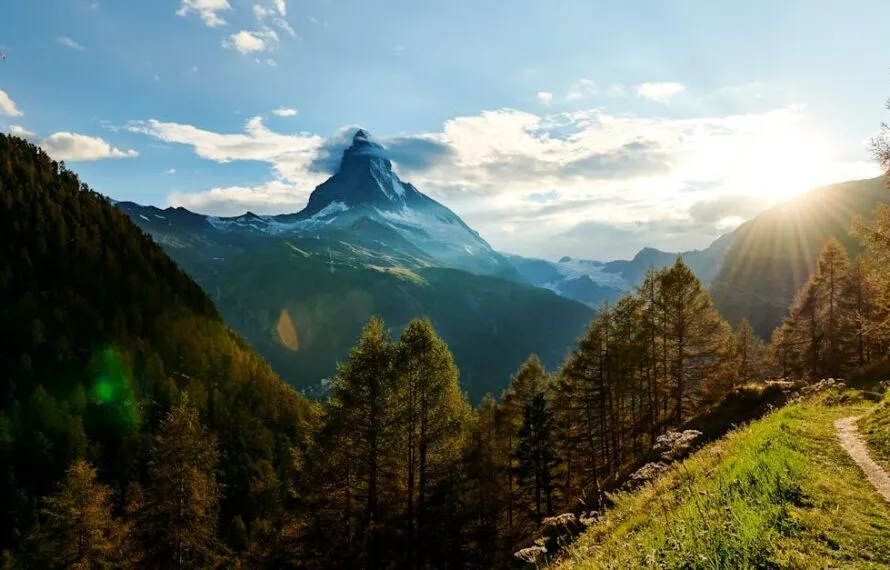The Matterhorn, with its iconic pyramid shape, stands as one of the most recognizable peaks in the world.
Nestled between Switzerland and Italy, this majestic mountain has captured the imagination of adventurers and climbers for centuries.
Its allure lies not only in its stunning beauty but also in the challenge it presents to those daring enough to reach its summit.
The Matterhorn’s significance extends beyond its physical presence; it symbolizes the spirit of exploration and the triumph of human determination.
O que este artigo aborda:
- Popular hiking routes to the Matterhorn summit
- Hörnli Ridge route
- Lion Ridge route
- Zmutt Ridge route
- Preparing for a Matterhorn hike
- Physical fitness requirements
- Necessary gear and equipment
- Safety considerations
- Weather conditions in summer
- Altitude sickness awareness
- Guided tours and local guides
- Benefits of hiring a guide
- Recommended tour operators
- Environmental and ethical considerations
- Leave no trace principles
- Respecting local wildlife and flora
- Alternative activities around the Matterhorn
- Nearby hiking trails
- Other adventure sports
Popular hiking routes to the Matterhorn summit
When considering what hiking routes lead to the Matterhorn summit in summer, several paths offer unique experiences and challenges.
Each route provides a different perspective of the mountain, allowing climbers to appreciate its grandeur from various angles.
Hörnli Ridge route
The Hörnli Ridge route, often referred to as the “normal route,” is the most popular path to the summit.
Starting from the Hörnli Hut, this route offers a mix of rock climbing and scrambling.
Climbers must navigate through steep sections and exposed ridges, demanding both physical endurance and mental fortitude.
The Hörnli Ridge is not for the faint-hearted, but it rewards those who persevere with breathtaking views and a sense of accomplishment.
Lion Ridge route
The Lion Ridge route, originating from the Italian side, presents a slightly more challenging alternative.
This path requires climbers to traverse the Lion’s Head, a prominent feature that adds an element of excitement to the ascent.
The route demands technical climbing skills and familiarity with alpine conditions.
However, the effort is well worth it, as climbers are treated to unparalleled vistas of the surrounding peaks and valleys.
Zmutt Ridge route
For those seeking a less crowded and more adventurous experience, the Zmutt Ridge route offers a thrilling option.
This path is less frequented, providing a sense of solitude and connection with nature.
Climbers must navigate through mixed terrain, including rock, ice, and snow.
The Zmutt Ridge demands a high level of technical proficiency and experience in alpine climbing.
However, the reward is an unforgettable journey through some of the most stunning landscapes the Alps have to offer.
Preparing for a Matterhorn hike
Embarking on a journey to the Matterhorn summit requires careful preparation and planning.
Climbers must ensure they are physically and mentally equipped to tackle the challenges that lie ahead.
Physical fitness requirements
Climbing the Matterhorn is a demanding endeavor that requires peak physical fitness.
Climbers should engage in regular cardiovascular and strength training exercises to build endurance and stamina.
Additionally, practicing climbing techniques and honing balance and agility skills is crucial.
A well-rounded fitness regimen will enhance the overall climbing experience and reduce the risk of injury.
Necessary gear and equipment
Proper gear and equipment are essential for a successful Matterhorn ascent.
Climbers must invest in high-quality climbing boots, harnesses, helmets, and ropes.
Additionally, weather-appropriate clothing, including layers for warmth and protection against wind and rain, is vital.
Carrying a reliable map, compass, and GPS device ensures navigational accuracy.
Adequate preparation and the right gear contribute significantly to a safe and enjoyable climb.
Safety considerations
Safety is paramount when climbing the Matterhorn, especially during the summer months when weather conditions can be unpredictable.
Weather conditions in summer
Summer weather in the Alps can change rapidly, with clear skies giving way to sudden storms.
Climbers must stay informed about weather forecasts and be prepared to adjust their plans accordingly.
Early morning starts are advisable to avoid afternoon thunderstorms.
Additionally, climbers should be aware of the risk of rockfall, which increases during warmer temperatures.
Altitude sickness awareness
Altitude sickness poses a significant risk when climbing the Matterhorn.
Climbers should acclimatize gradually by spending time at higher altitudes before attempting the summit.
Recognizing the symptoms of altitude sickness, such as headaches, nausea, and dizziness, is crucial.
Descending immediately if symptoms worsen is essential to prevent serious health complications.
Guided tours and local guides
Hiring a local guide can enhance the climbing experience and provide valuable insights into the mountain’s unique features.
Benefits of hiring a guide
Guides offer expertise in navigating the challenging terrain and can provide essential safety tips.
They are familiar with the routes and can offer guidance on the best times to climb.
Additionally, guides can share fascinating stories and historical anecdotes about the Matterhorn, enriching the overall experience.
Recommended tour operators
Several reputable tour operators offer guided climbs to the Matterhorn summit.
These operators provide experienced guides, comprehensive safety briefings, and logistical support.
Researching and selecting a reliable tour operator ensures a well-organized and enjoyable climbing experience.
Environmental and ethical considerations
Respecting the natural environment and local communities is crucial when climbing the Matterhorn.
Leave no trace principles
Climbers must adhere to Leave No Trace principles, ensuring they leave the mountain as pristine as they found it.
This includes packing out all trash, minimizing campfire impact, and respecting wildlife habitats.
Preserving the natural beauty of the Matterhorn for future generations is a shared responsibility.
Respecting local wildlife and flora
The Matterhorn is home to diverse wildlife and unique plant species.
Climbers should avoid disturbing animals and tread carefully to protect fragile flora.
Observing wildlife from a distance and refraining from feeding animals are essential practices to maintain the delicate balance of the ecosystem.
Alternative activities around the Matterhorn
For those who prefer to admire the Matterhorn from a distance or seek alternative adventures, the surrounding area offers a plethora of activities.
Nearby hiking trails
The region boasts numerous hiking trails that provide stunning views of the Matterhorn without the need for technical climbing.
Trails such as the Gornergrat and the Five Lakes Walk offer breathtaking panoramas and opportunities to immerse oneself in the alpine landscape.
Other adventure sports
In addition to hiking, the Matterhorn region offers a range of adventure sports, including paragliding, mountain biking, and rock climbing.
These activities provide thrilling experiences and allow visitors to explore the area from different perspectives.
In conclusion, the Matterhorn stands as a beacon of adventure and exploration.
Whether you choose to tackle the Hörnli Ridge, Lion Ridge, or Zmutt Ridge, each route offers a unique and rewarding experience.
Proper preparation, respect for the environment, and a spirit of adventure are key to a successful Matterhorn climb.
So, lace up your boots, gather your gear, and embark on an unforgettable journey to the summit of this iconic peak.





Sem comentários